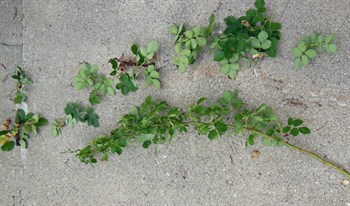Summer pruning for climbing and shrub roses: The least
photogenic process
We've been trying for years to illustrate rose pruning with
photos of real roses. Although rose flowers are
very photogenic, a whole rose shrub or vine tends to come across as
a jumble in a photo. Here are some exceptions to that rule, images
that help you do what must be done: See and choose between canes.
And you may also want to take a look at*
•
What's Coming Up 86 pruning guide,
• The illustrations of a trellised climbing rose in
What's Coming Up 157, and
• What's
Coming Up 88
photos.
*(Sponsor
us, name this topic as your chosen topic, and
you will grant us the time to blend and compile them!)
Summer is time to deadhead, cut
back and train roses, all at
once
The goals:
- Cut back wood that's bloomed, in time to encourage the shrub to
develop lots of new shoots from the main framework.
- And to fine tune that framework by cutting back any
weak wood.
- Then to train in or remove new canes.
Sometimes it's a light cut, but more often heavy
If a rose grew and bloomed especially heavily, it will lose a
lot now. Not to worry -- if it's a vigorous, healthy rose it will
take it in stride.
Below: This miniature climber 'Red Cascade' lost very little
to our pruners this week... but that's because it started growing
and blooming so early this spring that we had already given it its
first cut about three weeks ago.
(You might notice, if you've been looking at the other deadheading
and cutting back articles for this week, that we also clipped
back the Dianthus at its feet, as we do for potted
annuals about now. All plants look better when their companions are
fresh.)


Below: This very big 'Climbing New Dawn' loses a lot
more.
It's quite the good grower and at its peak as we do this main
clipping, post-bloom. We also prune a bit in fall if it has any
long straggler canes that might whip in the winter wind. In the
spring we cut the tips of the main canes, remove and deadwood and
even up the side shoots that are in place to bloom.


Below: These carpet-type roses lost more than usual because
they went wild this spring after a very mild winter and very early
warm-up. We missed being able to prune them before they started to
grow so we opted to put up with their sprawl through the first
bloom. But now, the jig's up and we must rein them in.


How-to of cutting
back
First, identify the side branches -- the offshoots of the main
canes. They bore the flowers.
Right: The left-hand cane in this photo is a branch that
matured last summer and this spring produced four side shoots.
We'll cut each side shoot now to remove its bloomed-out tip.
The right-hand cane is new, every inch of it grown since
spring -- such is the energy of youth. We'll deadhead it and cut
its tip to encourage side shoots for the next round of bloom. Or
we'll let it bloom and remove the entire shoot, as there are so
many this year.
Below: We work along each main cane, clipping back
bloomed-out side shoots. We keep just the base of the spur, one or
two leaves per shoot.


Below, left: Sometimes we run across particularly vigorous
side branches, such as this one in the middle of the cane.
Below, right: We've clipped all the other side shoots
along the cane, leaving the unsual branch (arrow) as we contemplate
its future.


 Right: It's alrady developing an equally
sturdy shoot from its base. Can we use more main branches? If not,
we cut.
Right: It's alrady developing an equally
sturdy shoot from its base. Can we use more main branches? If not,
we cut.
Training
The real catch to training is being tough enough to say "no" to
perfectly healthy canes that emerge in the wrong places, or that
are simply not needed.
Below, left: This Explorer series climber* gave up a bit
more green this year than in other years because...
Below, center: ...a sturdy new cane (a) presented itself and
we decided to train it in place of older cane (b). Cane (b) has
some damage on it (not visible in these photos) but what's more
important is that we didn't position it well when we first trained
it, and can't reposition it now that it's thick and woody. We left
its lower section quite vertical, without bows or bends, so along
that section it was not encouraged to break -- develop blooming
side shoots.
Thus it's bare-ankles ugly along its first four feet. By
comparison, bowed cane (c) has lots of breaks.
Below, right: There we go. The old cane's sawed out. The new
cane's bowed and tied in.



*(Which Explorer... hmm.)